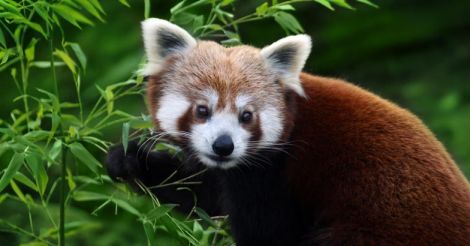The red panda is a shy, endangered and majestic, medium sized mammal belonging to the super family Musteloidea. This highly endangered mammal inhabits mountainous bamboo forests across South East China, Eastern (Darjeeling Himalayas of West Bengal and Sikkim Himalayas in the state of Sikkim) and North Eastern (Arunachal Pradesh) India, Nepal Himalayas (Nepal), Bhutan Himalayas (Bhutan) as well as heavily forested parts of Northern and Western Myanmar (formerly Burma) bordering China and India, respectively.
The animal is not related to giant panda but due to some superficial similarities is also known by the name lesser panda or red bearcat, although it is not related to any of these mammals taxonomically nor genetically. The super family Musteloidea includes other smaller mammals like raccoons, weasels, skunks along with red panda. Two sub species of red panda have been reported from their entire range of distribution and unfortunately, both are seriously endangered.
 Red Panda. Photo: Getty Images
Red Panda. Photo: Getty ImagesIt is quite unfortunate to note that Red panda has been seriously impacted by habitat loss and habitat fragmentation in China, India, Nepal, and Myanmar. The rich Himalayan bamboo forests together with the dense and gregarious bamboo forests in China and Myanmar have been seriously impacted due to heavy anthropogenic footprints for the commercial and domestic use of bamboo over the past few decades.
Furthermore, domestic dogs thriving in human settlements encroaching into red panda habitats are known to attack and kill these rare mammals making them extremely vulnerable to diseases as well as life threatening injuries.
Poachers and wildlife traffickers active in the red panda range across international borders have been another menace impacting wild populations of the red panda for the international, illegal wildlife trade marks operating in South China, Hong Kong and pockets of South East Asia. Illegal capturing of baby red pandas and transportation across the international border has been causing serious impacts to their wild populations.
Many of the adult animals are killed to collect their helpless cubs in the wild for the illegal wildlife trade markets ruthlessly. Infant mortality during long transportation process, due to lack of proper care, infections and dehydration, is been one of the leading cause of endangerment of wild red pandas, in addition to habitat loss and habitat fragmentation.
 Red Panda. Photo: Getty Images
Red Panda. Photo: Getty ImagesThe red panda conservation is extremely challenging as the distribution of the species across its range cover several sovereign nations. Hence, without significant cooperation between the adjacent countries, it is quite unlikely that Red panda could be effectively protected as a species in any one of these nations, including India. The Red panda habitat is subjected to severe anthropogenic encroachments from the local rural residents who are dependent on the adjacent forest resources for their daily sustenance. Several such remote rural communities live in abject poverty with very little opportunity to find local employment, any credible healthcare or facilities for rural rehabilitation. As a consequence, they are subjected to exploitation by drug, human and wildlife traffickers.
Most of the red panda habitats close to international border areas in inaccessible mountainous terrains are heavily forested on either side and are subjected to further exploitation by indigenous and foreign poachers. This makes survey for the red panda populations in the wild not only difficult but also highly expensive and labor intensive. Furthermore, some of these areas are heavily infiltrated by insurgents who like hiding from the security forces and intelligence agencies, making proper survey difficult from the perspectives of logistics, funding as well as security of the surveyors.
Hence, although an average estimation of around ten thousand individuals in the wild is projected by several international conservation agencies, the real picture could be even worse and may only have a few thousand left in the wild combining the entire range from South East China across Nepal, Bhutan, Eastern and North Eastern India and Northern and Western Myanmar.
Hence, an approach like Joint Conservation Initiative (JCI) could be the only plausible alternative for making real significant impact in red panda conservation across the entire range of their distribution. Countries having wild red panda sub-populations and sub-species must join efforts together for protecting this highly endangered, magnificent and shy mammal from the clutch of extinction in the wild.
 Red Panda. Photo: Getty Images
Red Panda. Photo: Getty ImagesIndia currently has two premier institutes involved in the captive breeding of red panda, namely Darjeeling Zoo in West Bengal and Gangtok zoo in Sikkim. More such red panda breeding centers are needed across South East China, India (in Arunachal Pradesh), northern Myanmar, Nepal and Bhutan. Some Chinese zoos and parks are also involved in the conservation of Red panda through captive breeding and releasing them into the wild. However, very little is known regarding conservation of red panda efforts in Myanmar. Nepal does have some strong international support for red panda breeding and conservation efforts that has helped partly in protecting the species in Nepal. The Bhutan government has an impressive wildlife and environment protection agenda and the mammal is best protected currently in Bhutan for that reason.
Adjacent national governments need to strengthen their Joint Border Management (JBM) efforts together with cooperation between adjacent border security agencies, customs and excise department, wildlife and forest departments, regional and international environmental agencies in coordination with local administration. Sharing intelligence reports between the red panda inhabiting countries to track poachers, wildlife traffickers and insurgents hiding across porous international borders will be an effective conservation management strategy to protect the species in the wild. Developing and recreating wild bamboo forest habitats and freeing those that are impacted with illegal anthropogenic encroachments will also help to regenerate the lost red panda habitats to protect this endangered species.
(The author is a Canada and India based freelance journalist specializing in global geo-political, strategic and foreign policy issues, science & technology and environment & conservation related themes.)
Read more: Columns | Conservation of snow leopard, the most beautiful feline species

























 The adorable red pandas are in trouble. Photo : Getty Images
The adorable red pandas are in trouble. Photo : Getty Images